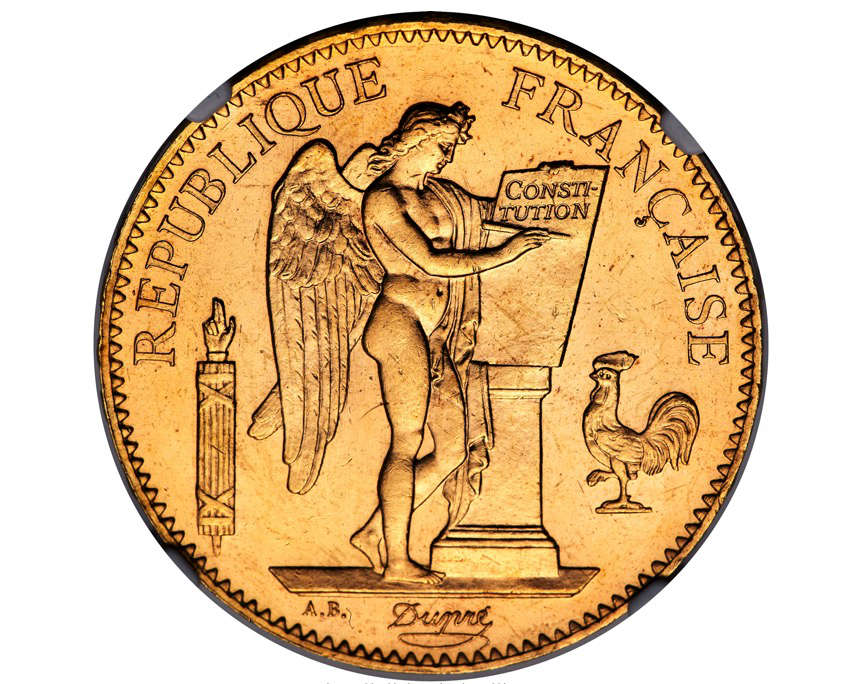Rare Coins from Around the Globe at Heritage’s World Coins Event
Heritage Auctions
World Coins Platinum Session
Coins
3-4 November 2023
US-Dallas
The upcoming Heritage sale of world coins features gold and silver coins from destinations as far-flung as Great Britain, France, Peru and Russia – all selected for their quality. Among the highlights is an Ultra-Rare 1894 French Gold Coin. The Prooflike near-Gem example of the rarest of all business-strikes from the prized Genie series of 1894 100 Francs will find a new home when it crosses the block in Heritage’s World Coins Platinum Session and Signature® Auction November 3-4.

Lot 30052: France, Republic. Gold 100 Francs 1894-A, Paris mint. MS64 Prooflike NGC. Estimate: $40,000-60,000.
The Republic gold 100 Francs 1894-A MS64 Prooflike NGC that will be up for grabs, from the KJR Collection, is from a mintage of just 143 pieces, only five of which – including the example offered in this auction – have earned this Prooflike designation across the grading services.
“This is an auction that is a continuation of clients taking advantage of the exceptionally high-grade coins that are consistently available at Heritage Auctions,” says Cris Bierrenbach, Executive Vice President of International Numismatics at Heritage Auctions. “This 100 Francs is exceedingly rare and a perfect example of the trophy-level items people are seeking to assume a centerpiece role in elite collections.
“The KJR Collection focuses on aesthetic top-grade 100 Francs from France and Monaco, as well as 100 Soles from Peru. The collector has always believed the series have been historically undervalued for their mintages and beauty, and the current market is starting to realize the wisdom in that mindset.”
Among the top Peruvian lots in the auction is an unquestioned rarity: one of just eight examples of a Republic gold 100 Soles 1958 MS65 NGC, Lima mint, KM231, Fr-78. Mintage: 101 certified by NGC. The 1958 is something of a holy grail to collectors, at least when compared to other dates that have more than 100 registered examples. This magnificent example, which comes from the VMF Collection, shares the top spot in the census, and it is noteworthy that this date has been offered at Heritage just once in the last eight years.

Lot 30018: Greek. Lydian Kingdom. Croesus (561-546 BC). Stater, ca. 550-546 BC, Sardes. NGC Choice AU 5/5 – 5/5. Croeseid „light“ standard. Estimate: $30,000-40,000.
One of the top ancient coins in the auction is an extraordinary Lydian Kingdom. Croesus (561-546 BC). AV stater (16mm, 8.07 gm). NGC Choice AU 5/5 – 5/5. In numismatic circles, Croesus is most famous for introducing the world’s first bimetallic standard, issuing coins of both gold and silver; coins previously were produced in electrum, a naturally occurring alloy of gold and silver. That naturally caused a number of problems, most notably because the proportions of gold to silver were inconsistent, and there is evidence suggesting that Croesus’ father, Alyattes, artificially manipulated the gold-to-silver ratio in his electrum coins in his favor.
A Marc Antony, as Triumvir and Imperator (44-30 BC), with Octavia. AV aureus (21mm, 8.27 gm, 12h). NGC Choice Fine 4/5 – 3/5, scratch comes from the Military mint that traveled with Antony and Octavia in Athens, circa 38 BC. The appearance of Octavia makes this the first lifetime issue featuring a Roman woman.

Lot 30001: Greek. Sicily, Syracuse. Time of Dionysius I (405-370 BC). Decadrachm, ca. 400 BC. Unsigned dies by the “shell engraver” in the style of Euainetos. NGC (photo-certificate) AU 4/5 – 2/5, Fine Style, light smoothing, scratches. Estimate: $25,000-35,000.
From the Eardley and Ethel Madsen Collection comes a Sicily. Syracuse. Time of Dionysius I (405-370 BC). AR decadrachm (34mm, 41.57 gm, 9h). NGC (photo-certificate) AU 4/5 – 2/5, Fine Style, light smoothing, scratches. Made from unsigned dies by the “shell engraver” in the style of Euainetos, ca. 400 BC. From a rare die combination, with only two examples cited in Gallatin, it features a racing quadriga driven left by charioteer, reins in left hand, kentron in right.
A Rare 1826 Concordiataler is among the survivors of a reported mintage of between 75 and 200 pieces. Rarely seen outside of Europe, it features a stylistic and forward-looking engraving of the Canton’s mint masters that features the symbols of Bern within vertical ellipses that are framed by peripheral rings that taper towards the northern and southern poles.

Lot 30093: Moldavia & Wallachia. Catherine II silver Pattern 2 Para – 3 Kopecks 1773, Sadagura mint. UNC Details (Obverse Spot Removed) NGC.Estimate: $20,000-30,000.
An incredibly rare Silver 2 Para of Moldavia & Wallachia is a spectacular and thoroughly rare emission in silver, and among Catherine II’s most difficult coinages to locate, with only seven auction appearances in the last two decades. The offered example is one of just two pieces currently certified and should be of great interest to Russian specialists. While circulation pieces were struck from captured Turkish cannon, according to Spassky, only a handful of off-metal Patterns were made in silver, likely for souvenir or presentation purposes at Peter Gartenberg’s estate “mint” in Sadagura.
A British Mandate Proof 100 Mils 1931 PR63 PCGS is the only Proof 100 Mils from 1931 certified by either service. It is a minimally available type overall, but this date in particular is the holy grail for the entire Palestinian series, almost never encountered in Mint State preservations, and certainly not in Proof.





